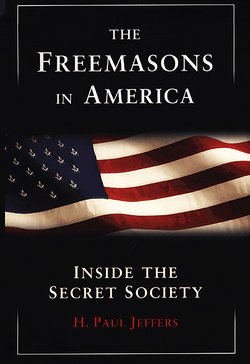Читать книгу The Freemasons In America: - H. Paul Jeffers - Страница 12
На сайте Литреса книга снята с продажи.
Chapter 4 Brother Washington
ОглавлениеBORN IN VIRGINIA ON FEBRUARY 22, 1732, GEORGE WASHINGTON became a Freemason in the lodge at Fredericksburg, Virginia, on August 4, 1753, at age twenty-one. When a lodge was chartered in Alexandria in 1788, he was named Charter Master. As president of the United States, he wrote to a lodge in Rhode Island in 1790, “Being persuaded that a just application of the principles on which the Masonic Fraternity is founded must be a promotive of private virtue and public prosperity, I shall always be happy to advance the interest of the Society and to be considered by them as a deserving brother.”
Although he wrote letters indicating that he was happy to be a Freemason and that he never sought to resign or repudiate his Masonic membership, there is little to no evidence that he attended many Masonic lodge meetings after his initiation in 1753 but he may have attended the dinners. He seems not to have participated in meetings of the lodge of which he was the first Master of what today is called Alexandria-Washington Lodge No. 22. While Master of the lodge, he did not assist in the work of the lodge. In one puzzling letter he denied that he was a Mason.
As commander in chief of the army, he was virtually surrounded by Masons. Half of his generals belonged to the Craft, including France’s Marie-Paul de Lafayette and the Prussian army officer Baron Friedrick von Steuben.
While they battled with regular English troops and mercenaries on land, John Paul Jones, a young seagoing Freemason who was born in Scotland and had embraced the American cause, carried the fight to the high seas by attacking British shipping and raiding English ports. Revered as the father of the U.S. Navy, Jones gave Americans one of their most stirring battle cries: “I have not yet begun to fight.”
While Freemasons are justifiably proud of Masons who served gallantly in the War for Independence, one of its most brilliant and heroic generals proved to be an embarrassment. Early in the war, Benedict Arnold (initiated in Connecticut in 1763) distinguished himself by leading an asault on Quebec, Canada. Wounded in the leg in the bold attack that failed to take the city, he emerged as a hero. During the Battle of Saratoga, he proved to be a brilliant strategist who again exhibited heroics. But the commander, General Horatio Gates, a Mason, relieved him of his command, in part for insubordination and in part because Gates viewed Arnold as a “pompous little fellow.” This insult to Arnold was assuaged following British abandonment of Philadelphia when Washington appointed him to the post of commandant of the city. But by this time he was an embittered figure with open disdain for his fellow officers and deep resentment toward Congress for not promoting him more quickly.
Arnold was also a widower who courted and married Margaret (Peggy) Shippen. Described as “a talented young woman of good family,” at nineteen she was half Arnold’s age and pro-British. Plunging into the social life of America’s largest and most sophisticated city by throwing lavish parties, Arnold was soon deeply in debt. This drew him into dubious financial schemes that caused Congress to investigate his activities, resulting in a recommendation that he be brought before a court-martial. He complained to Washington that having “become a cripple in the service of my country, I little expected to meet ungrateful returns.”
Confronted with personal and financial ruin, facing an uncertain future of promotion, and disgusted with politicians in Congress, Arnold made a fateful and ultimately ruinous decision to wipe out his troubles by offering his services to the British. Writing to their commander, Sir Henry Clinton, a Mason, he promised to deliver to the British the garrison at West Point, with 3,000 defenders, in the belief that the surrender would bring about the collapse of the American cause. To put himself in a position to do so, Arnold persuaded Washington to place the fort under his command. In September 1780, he was ready to act. To assist him in the plot the British chose Major John André, a Mason, as the go-between. The two men shared more than the conspiracy to neutralize West Point. Before Arnold married Shippen, André had been her suitor.
Serving with the Fifty-fourth Foot as adjutant general to General Clinton, André was also in charge of British spy operations. The plot involved coded letters and invisible ink. To make it easier for the British to take over, Arnold scattered his troops to weaken West Point’s defenses. Following a meeting with Arnold on September 21, 1780, André set out for his own lines in civilian clothes and carrying identification papers in the name of “John Anderson.” He was stopped by three suspicious Americans, taken to headquarters, searched, and exposed as a spy. Learning this, Arnold hastened to New York and the safety of his British allies.
When the British expressed a desire to gain André’s release, Washington sent Aaron Ogden, a prominent political leader (and Mason), to inform General Clinton that he would release André only in exchange for Arnold. Clinton refused and André was hanged on October 2, 1780. He accommodated his executioner by placing the noose around his neck and tying his own handkerchief as a blindfold. His body was eventually disinterred and buried with much pomp as a hero in Westminster Abbey.
